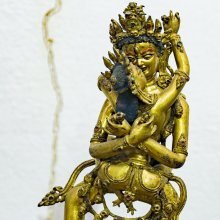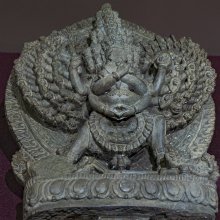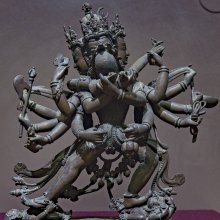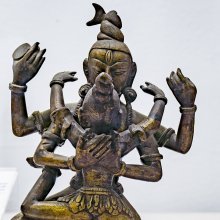Cakrasamvara, Cakrasaṃvara: 6 definitions
Introduction:
Cakrasamvara means something in Buddhism, Pali, Hinduism, Sanskrit. If you want to know the exact meaning, history, etymology or English translation of this term then check out the descriptions on this page. Add your comment or reference to a book if you want to contribute to this summary article.
Alternative spellings of this word include Chakrasamvara.
Images (photo gallery)
(+11 more images available)
In Buddhism
Tibetan Buddhism (Vajrayana or tantric Buddhism)
Source: OSU Press: Cakrasamvara SamadhiCakrasaṃvara (चक्रसंवर) (also: Heruka) is the name of a deity worshiped in the Saṃvaramaṇḍala, according to Abhayākaragupta’s Niṣpannayogāvalī, p. 45 and n. 145; (Cf. Cakrasaṃvaratantra, Gray, David B., 2007).—Accordingly, [while describing the iconography of Cakrasaṃvara]: “In the Saṃvara Maṇḍala atop Mount Sumera within a vajra-canopy (vajrapañjara) there is a variegated lotus, on top of that a palace, in the middle of which is the Blessed Lord, standing in ālīḍhāsana, "archer's pose", on Bhairava and Kālirātrī, lying upon a solar-disc, atop the pericarp of the lotus, dark-blue with four faces, which starting in the front (and going counter-clockwise) are dark-blue, green, red and yellow, each with trinetra, "three eyes", [...]”
Source: MDPI Books: The Ocean of HeroesCakrasaṃvara (चक्रसंवर) and saṃvara are native terms that can be found in the texts belonging to this scriptural tradition and are used to indicate aspects of this scriptural tradition. The word saṃvara in this scriptural tradition originally comes from the Śaiva concept of śaṃvara, “the supreme pleasure,” In that scriptural tradition in Buddhism, the word saṃvara has multiple meanings. [...]

Tibetan Buddhism includes schools such as Nyingma, Kadampa, Kagyu and Gelug. Their primary canon of literature is divided in two broad categories: The Kangyur, which consists of Buddha’s words, and the Tengyur, which includes commentaries from various sources. Esotericism and tantra techniques (vajrayāna) are collected indepently.
Languages of India and abroad
Sanskrit dictionary
Source: Cologne Digital Sanskrit Dictionaries: Shabda-Sagara Sanskrit-English DictionaryCakrasaṃvara (चक्रसंवर).—m.
(-raḥ) The name of a Baud'dha deity; also heramba. E. cakra a discus, and saṃvara who holds.
Source: Cologne Digital Sanskrit Dictionaries: Monier-Williams Sanskrit-English DictionaryCakrasaṃvara (चक्रसंवर):—[=cakra-saṃvara] [from cakra] m. Name of a Buddha (vajra-ṭīka), [cf. Lexicographers, esp. such as amarasiṃha, halāyudha, hemacandra, etc.]
[Sanskrit to German]
Sanskrit, also spelled संस्कृतम् (saṃskṛtam), is an ancient language of India commonly seen as the grandmother of the Indo-European language family (even English!). Closely allied with Prakrit and Pali, Sanskrit is more exhaustive in both grammar and terms and has the most extensive collection of literature in the world, greatly surpassing its sister-languages Greek and Latin.
See also (Relevant definitions)
Partial matches: Cakra, Samvara.
Starts with: Cakrasamvaranayika, Cakrasamvarasamadhi, Cakrasamvaratantra, Cakrasamvaratantravritti.
Full-text (+1898): Guhyavajrini, Pushpadhishthana, Sahasrabhuja, Vajradhatvishvari, Jvalanalarka, Sharajala, Mantrapatradhishthana, Mantrakarotaka, Mahakalpagni, Dhumrandhakara, Damshtrakarala, Shankhadhishthana, Vitana, Dhumra, Prakara, Vajraprakara, Kalanka, Utkata, Vajrakilaya, Agnisamnibha.
Relevant text
Search found 4 books and stories containing Cakrasamvara, Cakrasaṃvara, Cakra-samvara, Cakra-saṃvara; (plurals include: Cakrasamvaras, Cakrasaṃvaras, samvaras, saṃvaras). You can also click to the full overview containing English textual excerpts. Below are direct links for the most relevant articles:
Blue Annals (deb-ther sngon-po) (by George N. Roerich)
Chapter 1c - The Zur Geneology (xii): Jo bsod of dbus < [Book 3 - Early translations of Secret Mantra]
Chapter 5 - Cakrasaṃvara < [Book 7 - The preaching of the Tantras]
Chapter 6 - First incarnation series (iii): spom brag pa < [Book 8 - The famous Dakpo Kagyü (traditions)]
Guhyagarbha Tantra (with Commentary) (by Gyurme Dorje)
Commentary (the maṇḍala of contemplation)—Introduction < [Chapter 6 (text and commentary)]
Text 5.8 (Commentary) < [Chapter 5 (text and commentary)]
Text 9.4 (Commentary) < [Chapter 9 (Text And Commentary)]
The Indian Buddhist Iconography (by Benoytosh Bhattachacharyya)
Bodhisattvacharyavatara (by Andreas Kretschmar)
Text Sections 130-131 < [Khenpo Chöga’s Oral Explanations]
Related products





